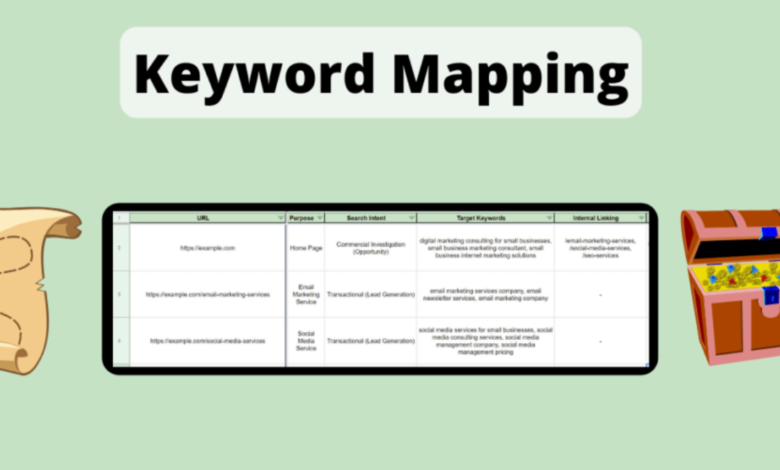Unraveling Keyword Mapping: A Comprehensive Guide to SEO Success

Keyword mapping is an essential strategy in search engine optimization (SEO) that can significantly impact the effectiveness of a digital marketing campaign. At its core, keyword mapping involves aligning specific keywords with corresponding pages on a website to improve visibility and relevance in search engine results. This strategic approach not only enhances user experience but also boosts the chances of ranking higher in search engines. In this guide, we’ll delve into the nuances of mapping, exploring its importance, best practices, and how it can drive your SEO efforts to new heights.
Understanding Keyword Mapping

Keyword mapping is the process of assigning keywords to specific pages on a website based on the content and intent of those pages. This practice is crucial for optimizing a website’s structure and ensuring that each page is targeting the most relevant keywords. By carefully mapping keywords to pages, businesses can improve their chances of ranking well in search engine results and attract more targeted traffic.
At its simplest, keyword involves identifying the keywords that are most relevant to your business or industry and then assigning those keywords to specific pages on your website. This process helps to ensure that each page is optimized for a particular set of keywords, making it more likely to appear in search results when users search for those terms.
Effective keyword mapping requires a deep understanding of both your target audience and the competitive landscape. You need to consider the search intent behind each keyword and how it aligns with the content of your website’s pages. This means analyzing not only the keywords themselves but also the context in which they are used and the user’s journey through your site.
The Importance of Keyword Mapping in SEO
Keyword mapping is a foundational element of SEO that plays a crucial role in driving organic traffic and improving search engine rankings. Proper mapping ensures that each page on your website is optimized for specific keywords, which can lead to higher visibility in search engine results pages (SERPs) and more targeted traffic.
One of the primary benefits of keyword is improved relevance. When each page on your website is optimized for a specific set of keywords, it becomes more relevant to users’ search queries. This increased relevance can lead to higher click-through rates (CTR) and a better user experience. When users find what they’re looking for quickly and easily, they are more likely to stay on your site and engage with your content.
Another key benefit of keyword is enhanced site structure. By assigning keywords to specific pages, you create a clear and logical hierarchy for your site’s content. This not only helps search engines understand the structure of your site but also makes it easier for users to navigate and find the information they need. A well-organized site structure can lead to better indexing by search engines and a more seamless user experience.
How to Conduct Keyword Mapping
Conducting keyword mapping involves several key steps, each of which contributes to creating a well-optimized and user-friendly website. From researching keywords to assigning them to the appropriate pages, this process requires careful planning and execution. Here’s a breakdown of how to effectively conduct keyword mapping.
The first step in mapping is keyword research. This involves identifying the keywords that are most relevant to your business, industry, or niche. Start by brainstorming a list of potential keywords and then use keyword research tools to analyze search volume, competition, and relevance. Look for keywords that have a high search volume but relatively low competition to maximize your chances of ranking well in search results.
Once you’ve identified a list of keywords, the next step is to categorize and group them. This involves organizing your keywords into clusters based on their relevance and search intent. For example, you might group keywords related to a specific product or service together, or categorize keywords based on different stages of the buyer’s journey. This categorization will help you determine which keywords are best suited for different pages on your website.
The final step in keyword is assigning keywords to specific pages on your site. This involves matching each keyword or keyword group with the page that is most relevant to that term. Consider the content and purpose of each page and ensure that the keywords you assign align with the page’s topic and user intent. Be sure to also consider on-page SEO factors such as meta titles, descriptions, and header tags when mapping your keywords.
Best Practices for Keyword Mapping
Implementing keyword mapping effectively requires adherence to several best practices to ensure that your SEO efforts are both efficient and impactful. By following these guidelines, you can maximize the effectiveness of your keyword mapping strategy and achieve better results in search engine rankings.
One important best practice is to prioritize user intent. When assigning keywords to pages, focus on the search intent behind each keyword. Consider what users are looking for when they search for a particular term and ensure that your page content meets those needs. Aligning your keywords with user intent helps create a more relevant and valuable experience for visitors, which can lead to higher engagement and conversions.
Another key practice is to avoid keyword cannibalization. Keyword cannibalization occurs when multiple pages on your site are optimized for the same keyword or keyword group, leading to competition between your pages in search results. To avoid this, ensure that each page on your site is optimized for a unique set of keywords. This helps to prevent overlap and ensures that each page has a clear focus and purpose.
Regularly reviewing and updating your keyword mapping is also crucial for maintaining SEO effectiveness. As search trends and user behavior evolve, it’s important to revisit your keyword mapping strategy and make adjustments as needed. This includes updating keywords based on new trends, revising page content to better align with user intent, and optimizing existing pages to improve their performance in search results.
Tools and Resources for Keyword Mapping
There are numerous tools and resources available to assist with keyword mapping, each offering unique features and capabilities to enhance your SEO strategy. By leveraging these tools, you can streamline the keyword mapping process and gain valuable insights into your keywords and website performance.
Keyword research tools are essential for identifying and analyzing keywords. Tools like Google Keyword Planner, SEMrush, and Ahrefs provide valuable data on search volume, competition, and keyword trends. These insights help you make informed decisions about which keywords to target and how to allocate them across your website.
SEO audit tools can also be beneficial for keyword mapping. Tools like Screaming Frog and Moz offer features for analyzing your website’s structure, identifying keyword gaps, and assessing on-page SEO factors. These tools help you ensure that your keyword mapping strategy is effectively implemented and that your site is optimized for search engines.
In addition to these tools, there are various resources and guides available to help you stay informed about keyword mapping best practices and industry trends. Blogs, forums, and online courses provide valuable information on SEO techniques, keyword research, and keyword mapping strategies. Staying updated with the latest developments in SEO can help you refine your keyword mapping approach and achieve better results.
Common Mistakes to Avoid in Keyword Mapping
While keyword mapping is a powerful strategy for improving SEO, there are common mistakes that can undermine its effectiveness. By being aware of these pitfalls and taking steps to avoid them, you can ensure that your keyword mapping efforts yield the best possible results.
One common mistake is overloading pages with keywords. While it’s important to optimize pages for relevant keywords, stuffing a page with too many keywords can lead to keyword stuffing, which can negatively impact readability and user experience. Instead, focus on using keywords naturally and contextually within your content to maintain a balance between optimization and readability.
Another mistake is neglecting long-tail keywords. Long-tail keywords, which are longer and more specific phrases, can be highly valuable for targeting niche audiences and capturing more precise search intent. By focusing solely on short-tail or broad keywords, you may miss opportunities to attract highly targeted traffic. Incorporate long-tail keywords into your keyword mapping strategy to capture a wider range of search queries and improve your chances of ranking for specific terms.
Failing to monitor and adjust your keyword mapping strategy is another common mistake. SEO is an ongoing process, and search trends, user behavior, and keyword performance can change over time. Regularly review your keyword mapping strategy and make adjustments based on performance data and evolving trends. This includes updating keywords, revising page content, and optimizing for new search intents.
Measuring the Success of Keyword Mapping
Measuring the success of your keyword mapping efforts is crucial for understanding the impact of your strategy and making informed decisions about future optimizations. By tracking key metrics and analyzing performance data, you can gauge the effectiveness of your keyword mapping and identify areas for improvement.
One key metric to track is organic search traffic. Monitoring the amount of traffic coming to your site from search engines can help you assess whether your keyword mapping strategy is driving more visitors to your pages. Use tools like Google Analytics to track organic traffic and analyze trends over time.
Another important metric is keyword rankings. Tracking the rankings of your targeted keywords can provide insights into how well your pages are performing in search results. Tools like SEMrush and Ahrefs offer keyword-tracking features that allow you to monitor changes in rankings and evaluate the effectiveness of your keyword-mapping strategy.
Conversion rates are also a valuable metric for measuring success. Analyzing conversion rates for pages that are optimized for specific keywords can help you determine whether your keyword mapping is leading to desired actions, such as form submissions, purchases, or sign-ups. By tracking conversions, you can assess the impact of your keyword mapping on overall business goals and adjust your strategy accordingly.
The Future of Keyword Mapping
As SEO continues to evolve, keyword mapping will remain a fundamental aspect of optimizing websites for search engines. However, the approach to keyword mapping is likely to adapt to new trends and technologies in the digital landscape. Staying informed about these changes and adapting your keyword mapping strategy will be essential for maintaining SEO success.
One emerging trend is the increasing importance of user intent and semantic search. Search engines are becoming more sophisticated in understanding the context and intent behind search queries. This means that keyword mapping strategies will need to focus more on aligning content with user intent rather than solely targeting specific keywords. This shift emphasizes the need for high-quality, relevant content that addresses users’ needs and preferences.
Another trend to watch is the rise of voice search and conversational queries. With the growing use of voice assistants and smart speakers, search queries are becoming more natural and conversational. Keyword mapping strategies will need to incorporate long-tail and conversational keywords to capture these types of searches effectively. Adapting to voice search trends will help ensure that your content remains relevant and visible in an increasingly voice-driven search environment.
Finally, the integration of artificial intelligence and machine learning in SEO tools and algorithms will likely influence keyword mapping practices. AI-powered tools can provide more advanced insights and recommendations for keyword optimization, helping you refine your strategy and stay ahead of the competition. Embracing these technologies and incorporating them into your keyword mapping efforts will be key to achieving long-term SEO success.
In conclusion, keyword mapping is a critical component of SEO that involves aligning specific keywords with corresponding pages on a website to improve visibility and relevance in search engine results. By understanding the principles of keyword mapping, following best practices, and leveraging the right tools and resources, you can enhance your SEO efforts and drive more targeted traffic to your site. As the digital landscape continues to evolve, staying informed about trends and adapting your keyword mapping strategy will be essential for maintaining a competitive edge and achieving ongoing success in SEO.

